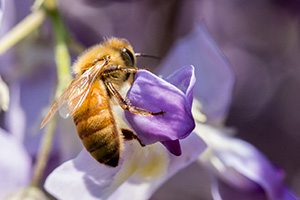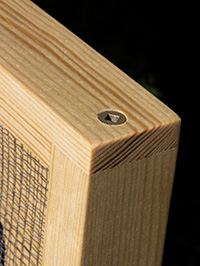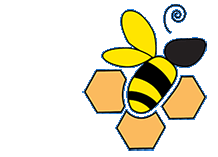





Why Choose Bee Furniture?
At Bee Furniture, we have taken pride in producing some of the highest quality and best looking hand-crafted honey bee hive kits available, since 2015. But there are also functional differences in our designs. Here are a few things that set Bee Furniture apart from other bee hives.
Every piece of Bee Furniture has been designed with bee health in mind. We don't just copy existing parts; we wanted to create a product that would maximize bee health, especially given the wet climate here in Coastal British Columbia, Canada, so we started from the ground up and designed all of our own equipment.
Our standard hive pieces are 100% compatible with existing Langstroth designs - we didn't want to change that, since it's what 99% of North American beekeepers use. So if you already have some bee hives, don't worry - our pieces will fit with your existing equipment just fine! But we did change some of the details. A big part of that has to do with ventilation: increasing airflow through the hive, even just slightly, greatly increases your chances of successfully overwintering your colony. So, our screened bottom boards and peaked outer covers work together to allow a slow, passive airflow from under the hive, through the boxes (while the bees regulate the airflow), and out through the peaked outer cover. This eliminates any chance of condensation forming on the inner cover and dripping down on the bees, which is a major cause of winter colony death on Vancouver Island. The airflow is not a vertical wind - we only want a slow movement of air (we don't want to chill the bees or brood!). Our bottom board and outer cover have been designed and fine-tuned specifically to give the bees just the right amount of ventilation.
Our standard hive pieces are 100% compatible with existing Langstroth designs - we didn't want to change that, since it's what 99% of North American beekeepers use. So if you already have some bee hives, don't worry - our pieces will fit with your existing equipment just fine! But we did change some of the details. A big part of that has to do with ventilation: increasing airflow through the hive, even just slightly, greatly increases your chances of successfully overwintering your colony. So, our screened bottom boards and peaked outer covers work together to allow a slow, passive airflow from under the hive, through the boxes (while the bees regulate the airflow), and out through the peaked outer cover. This eliminates any chance of condensation forming on the inner cover and dripping down on the bees, which is a major cause of winter colony death on Vancouver Island. The airflow is not a vertical wind - we only want a slow movement of air (we don't want to chill the bees or brood!). Our bottom board and outer cover have been designed and fine-tuned specifically to give the bees just the right amount of ventilation.
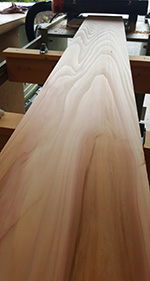
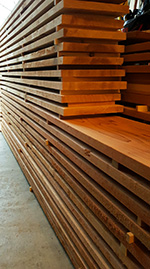
We are very careful with our selection of materials, and use only the highest quality wood, fasteners, and other hardware. We select each board carefully; cedar is milled specifically for us and then air-dried over a period of months before we plane it ourselves in small batches. Our kiln-dried spruce and pine is carefully selected for grain structure and straightness. We use only the best quality waterproof, non-toxic wood glue (Titebond III), along with coated deck screws that will not leave rust stains. We use screws on almost everything - the only nails you'll find will be galvanized roofing nails on the sides of the metal top (we won't perforate the top of any roof), and occasionally a few small brad nails which serve to clamp the wood while the glue sets on things like slatted racks and, of course, wood frames (which are glued and nailed).
After being milled to our specifications, we air-dry all of our cedar over a period of months.
Once the cedar is dry, we plane in small batches and immediately cut the parts we need for your order.
When we build our hive boxes (deeps and mediums), we don't just cut a pile of sides and a pile of ends. Each box (both cedar and pine) starts as a single board, from which we cut two sides and two ends. Those pieces are then labeled so that all four pieces will only ever be assembled together as a single box. Yes, it takes a little more time, but because the grain matches on each piece of any one box, it ensures that any expansion and contraction due to changes in humidity affect the entire box evenly, so the wood will not split. It also creates a continuity of grain characteristics throughout any one box, which makes each box unique.
We do not use finger joints (box joints) on any of our equipment, for much the same reason. Finger joints slightly increase the surface area of the joint, but they also create a much larger amount of exposed end-grain. Wood will always absorb water the most from the end-grain, so minimizing end-grain while maximizing joint surface area creates the strongest joint while reducing expansion and contraction across the joint. Look at any finger-jointed hive box over 5 years old and you'll see why they're not the best choice for our climate: they develop end-grain cracks or splits in the wood, even if well protected with paint or other finishes. For this reason, every piece of Bee Furniture is built with rabbet joints, which decrease end-grain and minimize the chance of splitting. Rabbet joints and creating boxes from a single board, as explained above, virtually eliminates the chances of splitting, and creates a product that will last many years.
We do not use finger joints (box joints) on any of our equipment, for much the same reason. Finger joints slightly increase the surface area of the joint, but they also create a much larger amount of exposed end-grain. Wood will always absorb water the most from the end-grain, so minimizing end-grain while maximizing joint surface area creates the strongest joint while reducing expansion and contraction across the joint. Look at any finger-jointed hive box over 5 years old and you'll see why they're not the best choice for our climate: they develop end-grain cracks or splits in the wood, even if well protected with paint or other finishes. For this reason, every piece of Bee Furniture is built with rabbet joints, which decrease end-grain and minimize the chance of splitting. Rabbet joints and creating boxes from a single board, as explained above, virtually eliminates the chances of splitting, and creates a product that will last many years.
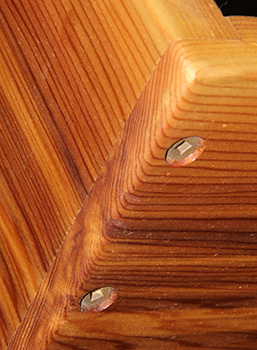
Finally, each piece is carefully sanded by hand - a process that usually takes a few hours on a standard pine or cedar kit. Once surface prep is complete, we apply your choice of finish. Gel stains and each of the four (or more) coats of natural oil finishes is hand-rubbed for an even finish. If you've opted for a painted kit, the attention to detail is the same - we still hand-sand every piece before the paint is applied, and some interesting accents are added for a fun and visually appealing final product. As is standard in Best Management Practices for beekeeping, finish is only applied to the exterior surfaces, leaving the inside surfaces as bare wood for the bees to propolize and customize to their liking.
The end product is the result of between 10 and 15 hours of labour on each kit, which will become a focal point of your yard or apiary. You can rest assured that not only does your new Bee Furniture look great, but it is designed and built to last many years and keep your bees healthy and happy.
Finally, our personalized service does not end when the product is delivered. We are always happy to hear from you, so if you have any questions about your new Bee Furniture or would like a bit of advice from our Certified Bee Master on how best to care for your bees, we are always happy to help. One word of caution though - our passion runs deep, so we can (and often do) chat about bees for hours on end!
The end product is the result of between 10 and 15 hours of labour on each kit, which will become a focal point of your yard or apiary. You can rest assured that not only does your new Bee Furniture look great, but it is designed and built to last many years and keep your bees healthy and happy.
Finally, our personalized service does not end when the product is delivered. We are always happy to hear from you, so if you have any questions about your new Bee Furniture or would like a bit of advice from our Certified Bee Master on how best to care for your bees, we are always happy to help. One word of caution though - our passion runs deep, so we can (and often do) chat about bees for hours on end!
http://www.Bee-Furniture.com
Nanaimo, BC Canada
Tel: (250) 802-3991
info@bee-furniture.com
Nanaimo, BC Canada
Tel: (250) 802-3991
info@bee-furniture.com

